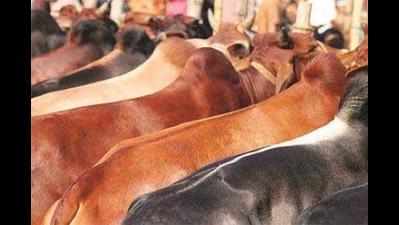- News
- City News
- nagpur News
- Holy cow! Cattle traffickers skirt beef ban
Trending
This story is from October 22, 2016
Holy cow! Cattle traffickers skirt beef ban
On August 23, cattle traffickers opened fire at a few vigilantes pursuing their trucks ferrying 63 cows on Nagpur-Chandrapur highway. On July 21, a family of three was killed and over 40 people injured when a truck driver illegally ferrying cows rammed at least 12 cars while trying to evade policemen in Amravati.

(Representative image)
On August 23, cattle traffickers opened fire at a few vigilantes pursuing their trucks ferrying 63 cows on Nagpur-Chandrapur highway. On July 21, a family of three was killed and over 40 people injured when a truck driver illegally ferrying cows rammed at least 12 cars while trying to evade policemen in Amravati.
Activists claim that rampant illegal transportation of cattle reveals the failure of ban’s purpose—protecting the “holy cow”.
With consumption and transportation of beef banned in the state, traffickers are finding innovative ways around it. Cows are transported in trucks concealed behind orange cartons or inside empty barrels and containers, or slaughtered discreetly in backyards and bathrooms. And, beef is often passed off as buffalo meat.
Police, however, have no data on the number of illegal cattle transportation cases since the ban on slaughter of cows, bulls and bullocks was imposed in March 2015. “We don’t have comprehensive data available for total number of cases registered in the region since the ban. District-wise records are maintained,” says Ravindra Kadam, inspector general of police, Nagpur range.
According to statistics provided by Sukrut Nirman Charitable Trust, which is working to save cows since 2002, 194 FIRs were registered between March 2015 and September 2016. The trust also claimed to have rescued over 1,000 cattle being transported in vehicles without any permit or doctor’s certification and lodged 81 FIRs in Bhandara, Gondia, Nagpur and
Wardha districts between March 2014 and February 2015.
But these are cases registered at the promptings of just one organization, the actual number could be much more.
Vishwa Hindu Parishad (VHP) claims 3,000 such FIRs have been registered in Vidarbha post-ban, of which they filed over 450.
Failure of beef ban could be due to several lacunae in the system. Many feel the ban was an impulsive decision. “It was directed towards vote bank and protecting the sentiments of one section of people. No thought was given to unproductive cows that end up being a burden on farmers,” says a po-
lice officer. “Also, not once did the government think about the butchers who have been in the profession for years.”
Ironically, the ban has resulted in more suffering for cattle it is meant to save. Last month, over 100 cattle being transported illegally died of suffocation. “Earlier, people would transport cattle openly and did not mind using more vehicles. Now, they are all stuffed in one vehicle,” says People For Animals city chief Karishma Galani.
Corruption and lack of knowledge of the Maharashtra Animal Preservation (Amendment) Act among police are other contributing factors behind miscarriage of the new law. “While lodging an FIR, police still use sections of Prevention of Cruelty to Animals Act 1960. They need to be sensitized about the provisions of Maharashtra Animal Preservation (Amendment) Act,” says retired veterinarian Shyam Kale.
Vijay Sharma, Vidarbha chief of VHP’s cow vigilant wing, says not a single case has been decided by any court. “Truck drivers or helpers are sent to police custody for a day or two and then given bail. At least, major cases should be tried in fast-track courts.”
End of Article
FOLLOW US ON SOCIAL MEDIA










